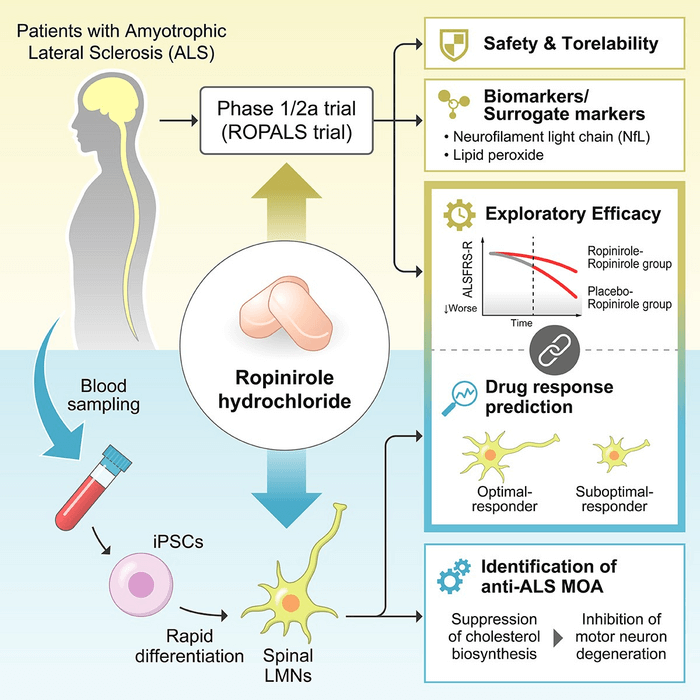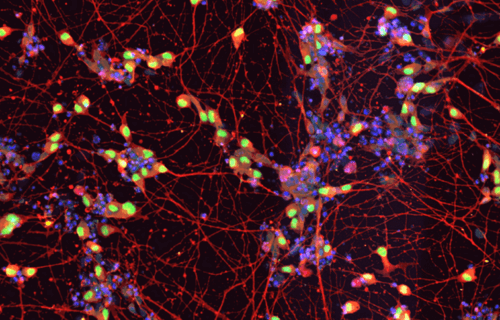TOKYO, Japan — A new study reveals that a common drug for treating Parkinson’s disease, ropinirole, can effectively slow the progression of amyotrophic lateral sclerosis (ALS) for over six months. ALS, which has claimed the lives of countless people, including renowned cosmologist Stephen Hawking, gradually causes people to lose muscle control. Currently, there is no cure and treatment mainly focuses on reducing symptoms and providing supportive care.
In the recent study, Japanese scientists demonstrated that ropinirole, which is typically used to alleviate the symptoms of both Parkinson’s and restless legs syndrome, is safe for ALS patients. Furthermore, it delayed the progression of the disease by an average of 27.9 weeks. The findings were published in the journal Cell Stem Cell, indicating that some patients were more responsive to ropinirole treatment than others.
“ALS is totally incurable, and it’s a very difficult disease to treat. We previously identified ropinirole as a potential anti-ALS drug in vitro by iPSC drug discovery, and with this trial, we have shown that it is safe to use in ALS patients and that it potentially has some therapeutic effect,” says the study’s senior author, Professor Hideyuki Okano from the Keio University School of Medicine in Tokyo, in a media release. “But to confirm its effectiveness we need more studies, and we are now planning a phase 3 trial for the near future.”
The team conducted tests on ropinirole’s safety and effectiveness in patients with sporadic ALS. They recruited 20 patients from Keio University Hospital who had been living with ALS, also known as Lou Gehrig’s disease, for an average of 20 months. None of the patients carried genes known to predispose them to the disease. Both patients and doctors were blind to who was receiving ropinirole or a placebo for the first 24 weeks of the study. Following that, all patients who chose to continue were openly administered ropinirole for the next 24 weeks.
Scroll down to see some of the famous individuals diagnosed with ALS

(credit: Morimoto et al/Cell Stem Cell)
Several measures were monitored throughout and four weeks after the trial to assess the drug’s efficacy in slowing the progression of ALS. These included changes in the patients’ self-reported physical activity, their ability to eat and drink independently, and activity data from wearable devices.
“We discovered that ropinirole is safe and tolerable for ALS patients and shows promise in helping them maintain daily activity and muscle strength,” says the study’s first author, Dr. Satoru Morimoto, a neurologist at the Keio University School of Medicine.
He found that patients who received ropinirole during both phases of the trial were more physically active than those in the placebo group. They also exhibited slower rates of mobility, muscle strength, and lung function decline, and they were more likely to survive.
The benefits of ropinirole compared to the placebo became more evident as the trial progressed. However, those in the placebo group who began taking ropinirole midway through the trial did not see these improvements. This suggests that ropinirole treatment may be beneficial only if administered earlier and over a more extended period.
Interestingly, the team found distinct differences in structure, gene expression, and metabolite concentrations between healthy motor neurons and those from ALS patients. However, ropinirole treatment diminished these differences.
“We found a very striking correlation between a patient’s clinical response and the response of their motor neurons in vitro. Patients whose motor neurons responded robustly to ropinirole in vitro had much slower clinical disease progression with ropinirole treatment, while suboptimal responders exhibited much more rapid disease progression despite taking ropinirole,” adds Dr. Morimoto.
While it remains unclear why some patients are more responsive to ropinirole than others, the researchers suggest genetic differences could be a contributing factor. They aim to investigate this further in future studies.
6 notable individuals with ALS
- Prof. Stephen Hawking: One of the world’s most renowned theoretical physicists, Hawking was diagnosed with ALS in 1963 at the age of 21. His condition progressed much slower than typical cases, and despite his physical limitations, he made groundbreaking contributions to the understanding of black holes and the Big Bang.

- Lou Gehrig: The famous American baseball player for whom the disease is named after in the United States. Gehrig was a Hall of Fame first baseman for the New York Yankees and was diagnosed with ALS in 1939, effectively ending his career.

- Jason Becker: A virtuoso guitarist diagnosed with ALS at the age of 20. Despite his disease, he continues to compose music with the movement of his eyes.
- Steve Gleason: A former NFL football player for the New Orleans Saints who was diagnosed with ALS in 2011. Gleason has since become an advocate for people with ALS and has worked to raise awareness about the disease.
- Augie Nieto: The founder of Life Fitness, Nieto was diagnosed with ALS in 2005. He dedicated his life to finding a cure for the disease until his death in February 2023.
- Neil Platt: A British architect who blogged about his life with ALS and was the subject of the 2014 documentary “I Am Breathing.”
South West News Service writer Stephen Beech contributed to this report.

